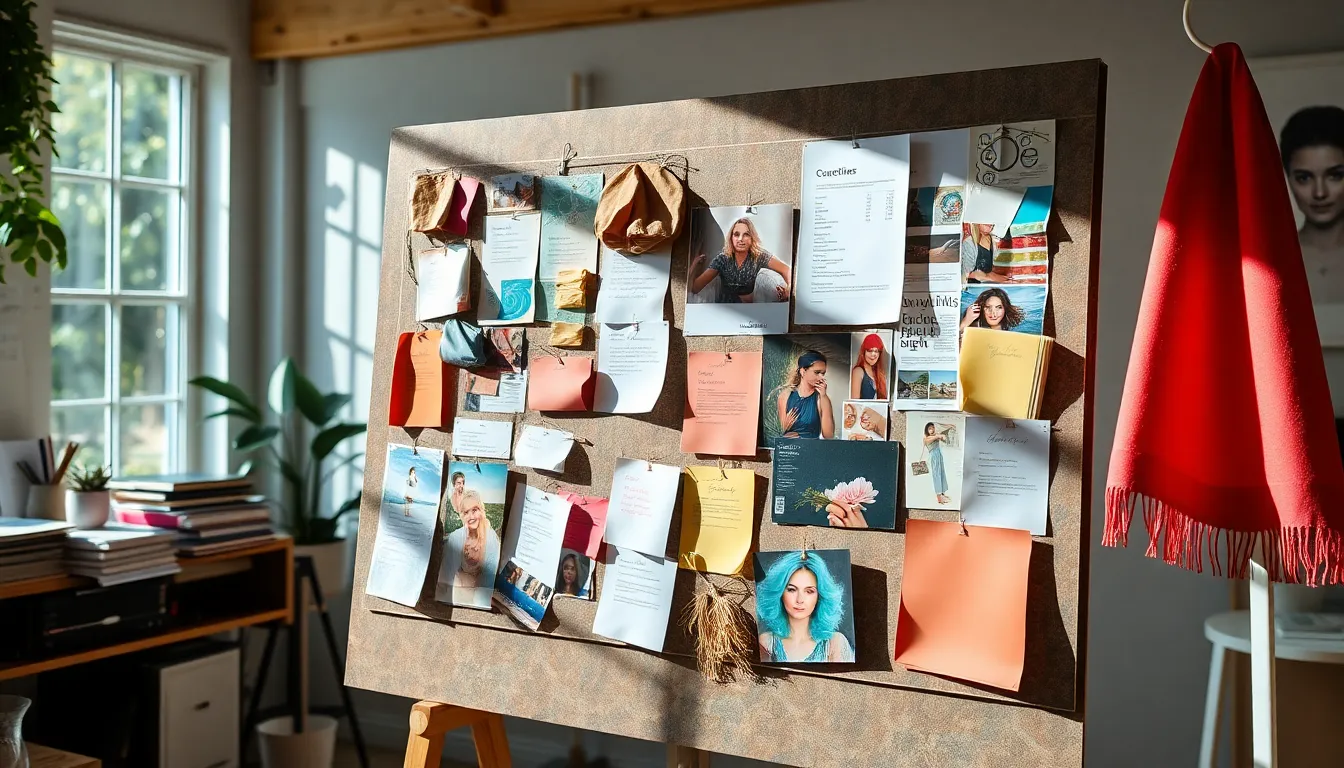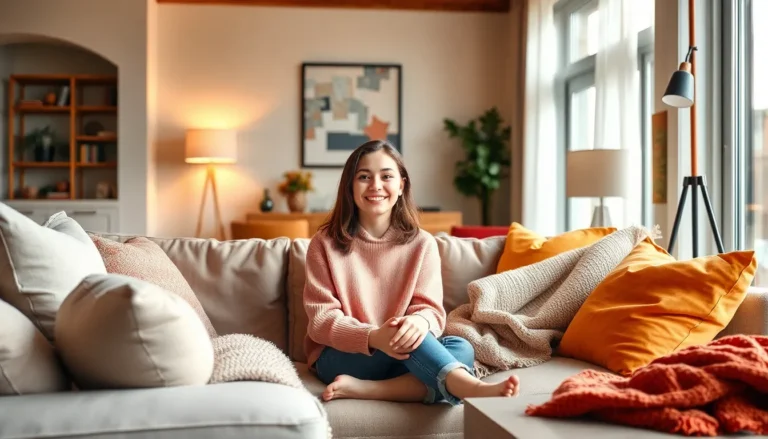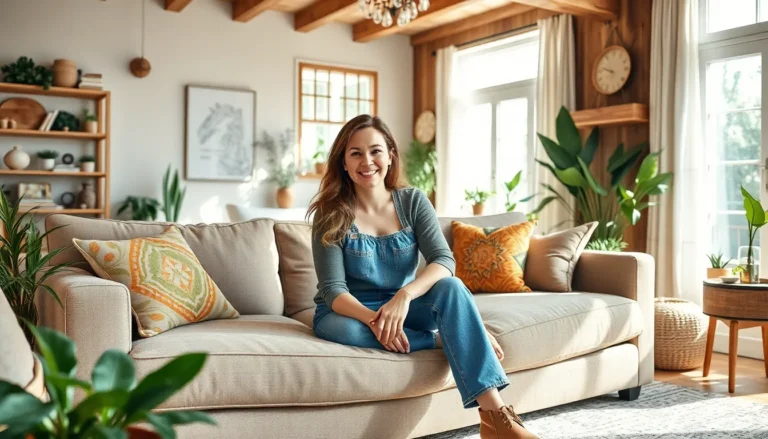Table of Contents
ToggleIn a world overflowing with ideas, an inspiration board can be a creative lifeboat. It’s like a mood ring for your projects—reflecting your dreams, aspirations, and maybe even that one time you thought you could pull off neon pink hair. Whether you’re planning a wedding, redesigning your home, or just trying to figure out what to binge-watch next, inspiration boards can help channel that chaotic whirlwind of thoughts into something tangible.
Overview of Inspiration Boards
Inspiration boards serve as organized collections of visuals and ideas that stimulate creativity. They assist individuals in clarifying their vision for projects, providing a platform to gather thoughts and imagery. These boards can take various forms, including physical boards made of cork or foam and digital formats like Pinterest or specialized apps.
Many utilize inspiration boards in wedding planning, combining images of dresses, flowers, and venues to establish a cohesive theme. Home redesign projects often benefit from color swatches, fabric samples, and furniture images displayed together for better visualization. Creative professionals—including graphic designers and architects—rely on these boards to communicate concepts and develop unique ideas.
Artists leverage inspiration boards to collect references, whether they seek color palettes or stylistic inspiration. Writers involve themselves in compiling excerpts, quotes, and visuals that resonate with their narrative’s theme. Students also find value in these boards; they can use them to explore research topics or create presentations.
The act of curating an inspiration board encourages reflection and organization. Each chosen element reflects individual taste, serving as a catalyst for artistic endeavors. By distilling complex ideas into visual forms, inspiration boards manage to crystallize abstract thoughts into specific goals.
Overall, inspiration boards function as powerful tools that channel creative energy. They facilitate the exploration of possibilities while providing a clear path forward in any creative undertaking.
Types of Inspiration Boards

Inspiration boards exist in various forms, catering to different preferences. Whether digital or physical, they serve as essential tools for organizing creative thoughts.
Digital Inspiration Boards
Digital inspiration boards offer flexibility and accessibility. Platforms like Pinterest or design apps allow users to compile images, quotes, and videos in one place. Users can easily rearrange their elements to adapt to evolving ideas. Collaborating with others becomes simple with shared boards, enhancing teamwork on projects. Saving time occurs when searching for visuals, eliminating the effort of gathering physical materials. Such boards enable quick adjustments, allowing for instant inspiration and creativity.
Physical Inspiration Boards
Physical inspiration boards bring tangible aspects to creativity. Cork boards, foam boards, or poster boards commonly serve as bases for visual projects. Individuals can pin photos, fabric samples, or sketches, creating a tactile experience. This hands-on approach encourages interaction, allowing users to feel their ideas more vividly. Organizing materials visually often sparks creativity, inspiring new connections. Displaying these boards in prominent spaces keeps goals and aspirations constantly visible, reinforcing focus on desired outcomes.
Creative Inspiration Board Ideas
Inspiration boards can take on many unique forms, each tailored to different aspects of creativity. Here are several ideas to enhance the effectiveness of these boards.
Thematic Inspiration Boards
Thematic inspiration boards revolve around specific concepts or ideas. In wedding planning, themes can center on vintage romance or modern elegance. For fashion projects, they might focus on seasonal trends like bohemian styles or minimalist aesthetics. Each selected image or item contributes to a cohesive narrative, helping individuals explore and define their vision. By gathering visuals that resonate with a particular theme, creators can streamline their design processes and ensure all elements complement each other effectively.
Color Palette Inspiration Boards
Color palette inspiration boards showcase color combinations to inspire design choices. Designers often source swatches from nature or art, collecting hues that evoke particular emotions. An earthy palette may combine rich browns and greens, while a vibrant scheme could feature bold reds and yellows. Each board allows creators to visualize how colors interact and establish moods. By comparing these palettes against projects, individuals can refine their color selections and achieve a harmonious appearance.
Mood and Aesthetic Boards
Mood and aesthetic boards serve to capture feelings and styles. These boards offer a visual representation of desired atmospheres, whether whimsical, serene, or dramatic. Curating images that evoke specific moods helps creators identify the emotions they want to convey. Gathering textures, patterns, and imagery enhances the overall experience. Such boards also serve as reference points, guiding decisions across various projects, from interior design to branding. Each visual element plays a crucial role in maintaining the intended vibe throughout the creative process.
Tips for Creating an Effective Inspiration Board
Creating an inspiration board combines creativity and organization to ignite innovative ideas. These tips enhance the effectiveness of inspiration boards connected to various projects.
Choosing the Right Materials
Selecting appropriate materials plays a crucial role. Cork boards or foam boards suit physical displays, providing a tactile experience. Digital options, like Pinterest or design apps, offer flexibility, allowing for easy adjustments. Materials should resonate with the project’s theme, ensuring each piece reflects the intended message. Incorporating vibrant colors and interesting textures stimulates engagement, making the board more appealing. Consider using mixed media by including fabric swatches or printed images. Each element should contribute to the overall aesthetic, aligning with initial creative goals.
Organizing Your Ideas
Clarity emerges through effective organization. Start by grouping similar themes or colors together for cohesive visual flow. Utilize sections on boards to differentiate ideas, making navigation easier. Placing important elements at the center captures attention and prioritizes key concepts. Visual hierarchies can intensify impact, emphasizing more significant inspirations. Adding labels or keywords alongside visuals further enhances understanding. Regular updates to the board keep it fresh and relevant, encouraging ongoing creativity. Every organized detail aids in forming a clear vision, supporting dynamic artistic exploration.
Creating an inspiration board is a powerful way to transform abstract ideas into concrete plans. Whether using a digital platform or a physical board, the process encourages individuals to reflect on their vision and organize their thoughts effectively. With various styles and themes available, inspiration boards can cater to any project or personal endeavor.
By regularly updating and engaging with these boards, creators can keep their goals in sight and their creativity flowing. Ultimately, inspiration boards not only serve as a source of motivation but also as a practical tool that enhances the creative journey, making it easier to navigate through ideas and aspirations.





